Fifteen Photographers at a Crossroads
A crossing implies movement across a physical border, but a photograph can also depict personal crossroads that lead to growth and change. Pictures can be transformative in their ability to deepen one’s sense of selfhood, or expand their understanding of identity. From Joel Meyerowitz to Susan Meiselas, Aperture and Magnum photographers have long demonstrated how photographs can spark change, both literal and metaphoric.
This week, for five days only, get signed and estate-stamped, museum-quality, 6-by-6-inch prints by acclaimed Aperture and Magnum photographers for $100 each. Use this link to make your purchase and a percentage of each sale will support Aperture Foundation. Visit Aperture Gallery through November 2 to view Crossings, a special exhibition hosted by Airbnb Magazine, featuring photographs from the sale.

Alessandra Sanguinetti, Belinda de Gaucho, Buenos Aires, Argentina, 1998
© the artist/Magnum Photos
Alessandra Sanguinetti
“Back in 1998 when I started taking pictures of Belinda and Guillermina, I asked Belinda what she thought she would have been like had she been a boy. She didn’t hesitate. She painted a mustache with a burnt cork, took off her shirt and looked straight at the camera.” —Alessandra Sanguinetti

Kwame Brathwaite, Untitled (Sikolo with Carolee Prince Designs), 1968
© the artist and courtesy Philip Martin Gallery
Kwame Brathwaite
“This is a picture of Sikolo Brathwaite, my wife and muse. The headpiece, inspired by South African beadwork, was designed by Carolee Prince, whose exquisite beadwork was also worn by Nina Simone and can be seen in many of my photos. This picture is part of the ‘Black Is Beautiful’ narrative—an embrace of African ancestry and unifying the black experience around the globe.” —Kwame Brathwaite

Nan Goldin, Drugs on the Rug. New York, 2016
© the artist
Nan Goldin
“I was addicted to OxyContin for four years. I overdosed but I came back. I decided to make the personal political. I’ve started a group called P.A.I.N. (Prescription Addiction Intervention Now) to address the opioid crisis. We are a group of artists, activists and addicts that believe in direct action. We target the Sackler family, who manufactured and pushed OxyContin, through the museums and universities that carry their name. We speak for the 250,000 bodies that no longer can.” —Nan Goldin
The photographer’s proceeds from the sale of this print will help fund the work of P.A.I.N.
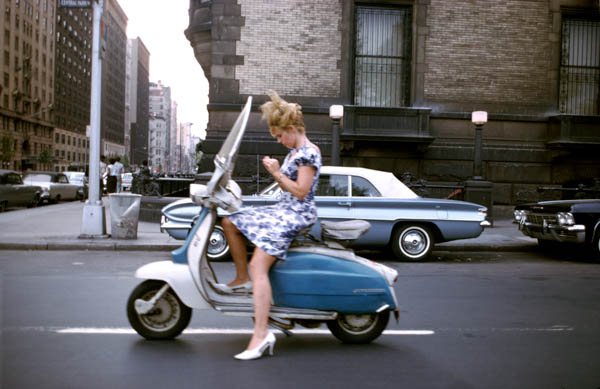
Joel Meyerowitz, New York, 1965
© the artist
Joel Meyerowitz
“A girl on a Vespa on her way to ‘who knows where,’ when the light stopped her at the 72nd street crossing near the Dakota, where John Lennon would one day cross paths with his fate. She takes this moment to finesse a fingernail before she resumes her downtown journey, while I, stopping at the same crossing, but on foot, leap into the street to capture this vision of a dream girl before time takes her on her way.” —Joel Meyerowitz
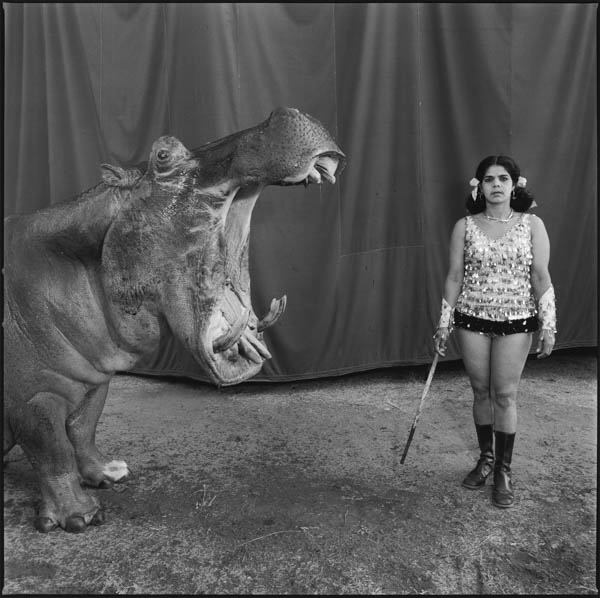
Mary Ellen Mark, Hippopotamus and Performer, Great Rayman Circus. Madras, India, 1989
© the artist
Mary Ellen Mark
“Photographing the Indian circus was one of the most beautiful, joyous, and special times of my career. I was allowed to document a magic fantasy that was, at the same time, all so real. It was full of ironies, often humorous and sometimes sad, beautiful and ugly, loving and at times cruel, but always human. The Indian circus is a metaphor for everything that has always fascinated me visually.” —Mary Ellen Mark, excerpt from Indian Circus (1993)

Pete Souza, Million Man March. Washington, D.C., 1995
© the artist
Pete Souza
“I had covered numerous protests and rallies on the National Mall in Washington, D.C. But the Million Man March surpassed all of those as an unforgettable experience. Hundreds of thousands of African American men gathered en masse for a peaceful rally, stretching from the U.S. Capitol to the Washington Monument. . . . I saw these two adult men with their sons, the golden light illuminating the Capitol. It was a symbolic moment of reflection, for them but also for me, on what this day meant.” —Pete Souza

Bruce Davidson, Brooklyn Gang, Backseat of a car, New York City, USA, 1959
©the artist/Magnum Photos
Bruce Davidson
“You’re looking at Lefty and his girlfriend, members of a Brooklyn gang who referred to themselves as ‘The Jokers,’ on a trip to Bear Mountain State Park. This photograph is not meant to be risqué. These were young, teenage kids who had a great deal of spirit, energy and love in lives that were reckless, unstable and oftentimes dangerous. . . .
The gang was completely out of their element. No mean streets, not a worry on their minds, just time to explore themselves and their surroundings. They were free, and it was captivating.”
—Bruce Davidson
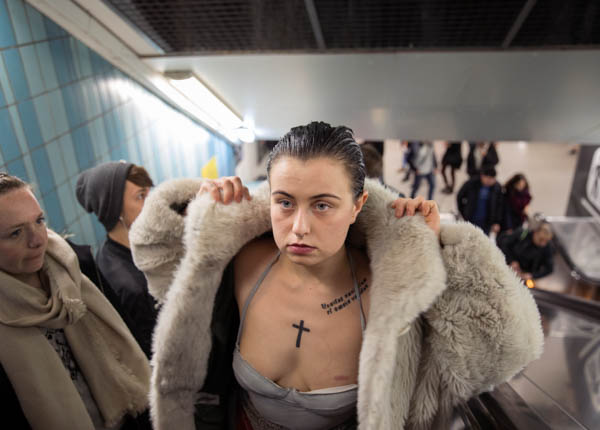
Bieke Depoorter, Agata, Paris, France, 2017
© the artist/Magnum Photos
Bieke Depoorter
“October 2017: I wandered around at night in Paris, looking for . . . someone that could help me translate the atmosphere in my mind with a story that would partially be theirs as well. The result, ‘Agata,’ is an ongoing project about a young woman I met at a striptease bar one of those nights, in which I explore my interest in collaborative portraiture. . . .
As Agata once wrote to me: ‘I am going to give you myself, and you will wrap it with Bieke, and I believe something beautiful can be created.’” —Bieke Depoorter
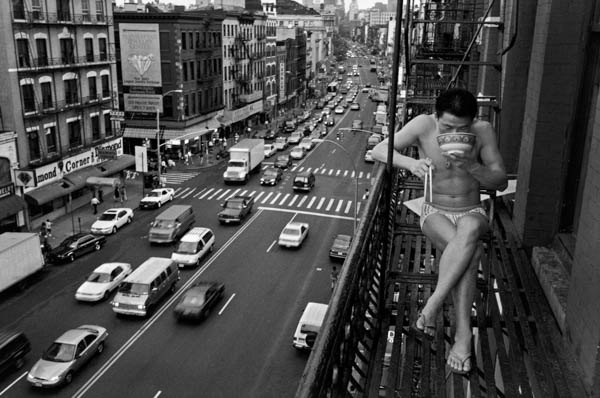
Chien-Chi Chang, A newly arrived immigrant eats noodles on a fire escape, New York, USA, 1998
© the artist/Magnum Photos
Chien-Chi Chang
“Humans need to hold hope in their hands. This man was willing to live in poverty in hope of prosperity. . . . A few years later, this man was able to bring his family to New York, and today they are living the American dream. He is now a grandfather! But is economic prosperity worth the social cost? Perhaps the answers to such questions can be found in the lives of the people left behind in China and in those of the second and third generations who are growing up in the United States. Look at them and listen to their voices. You may not understand their language, but you can feel their longing.” —Chien-Chi Chang

Olivia Arthur, Bombay, India, 2016
© the artist/Magnum Photos
Olivia Arthur
“I photographed Nikhil for my project ‘In Private, Bombay,’ an exploration of privacy, sexuality and the changing atmosphere in the city of Mumbai. . . . At the time there was a contradictory atmosphere in the city. At once an opening up of voices, boldness and desire to talk about sexuality. Yet, at the same time, there was growing Hindu conservatism and seeming regression across the country. The combination of audacity and intolerance made for a feeling of friction as well as excitement.” —Olivia Arthur

Susan Meiselas, Fifth Avenue, New York, 1977. From the series, “Volunteers of America”
© the artist/Magnum Photos
Susan Meiselas
“In 1977, I followed the men who performed as Santa Claus to raise funds for the Volunteers of America. They were recovering alcoholics, ringing bells on the street all day long. On Fifth Avenue, they crossed the lives of those who would never look at them otherwise.” —Susan Meiselas
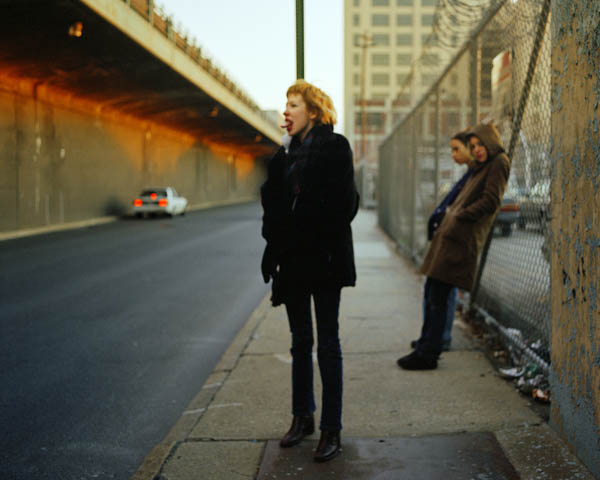
Justine Kurland, Tonguing BQE, 1997
© the artist
Justine Kurland
“The first condition of freedom is the ability to move at will, and sometimes that means getting into a car rather than getting out of one. It’s difficult to describe the joy of a carload of girls, going somewhere with the radio turned up and the windows rolled down. . . . At last we arrive at a view, a place where the landscape opens up—a place to plant a garden, build a home, picture a world. They spill out of the car along with candy wrappers and crushed soda cans, bounding into the frame, already becoming a photograph.” —Justine Kurland

Ethan James Green, Three Boys in Maheshwar, India, 2018
© the artist
Ethan James Green
“I was drawn to these three guys together. There was something alternative about them. They reminded me of myself when I was younger, all serious about doing the hair and the clothes. . . . I found it interesting the way they threw their arms around each other, in a place where male friendships seem to be expressed much more intimately than they are in the United States. I like this picture too because, when you look for a moment, you see that they all have smartphones in their hands. This detail seems right. Boys the same age all over the world who see this picture will understand exactly what’s going on and relate to it.” —Ethan James Green
The photographer’s proceeds from the sale of this print will be donated to Operation Smile.

Graciela Iturbide, Pájaros en el poste, carretera a Guanajuato (Birds on the post, highway to Guanajuato), Mexico, 1990
© the artist
Graciela Iturbide
“I was in my car on the highway to Guanajuato, and suddenly I saw this flock of birds. I love birds, for me they represent freedom.” —Graciela Iturbide

Alex Webb, Maquilla worker housing being built, Outskirts of Tijuana, B.C., 1995
© the artist/Magnum Photos
Alex Webb
“I’ve long been fascinated by the transience and paradoxes of the U.S.-Mexico border. Even though these two countries were culturally worlds apart, it sometimes seemed that the border region was a kind of third country between them—2,000 miles long and 10 miles wide, a place where two countries meet, sometimes easily, sometimes roughly, and often with a confounding note of surrealism. . . .
In 1995, while walking through the outskirts of Tijuana, I was surprised to find this box of brightly colored shoes, which seemed so out of place on this dusty, isolated embankment. . . . Was there a market here earlier—and these shoes left behind? . . . In my bad Spanish, I asked a passer-by if he knew. The old man just shrugged his shoulders.
To this day, this surreal scene remains a mystery.” —Alex Webb
This week, for five days only, get signed and estate-stamped, museum-quality, 6-by-6-inch prints by acclaimed Aperture and Magnum photographers for $100 each. Use this link to make your purchase and a percentage of each sale will support Aperture Foundation. Visit Aperture Gallery through November 2 to view Crossings, a special exhibition hosted by Airbnb Magazine, featuring photographs from the sale.






















